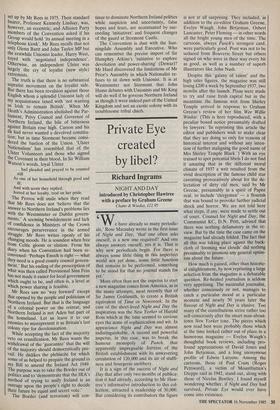Private Eye created by libel?
Richard Ingrains
NIGHT AND DAY introduced by Christopher Hawtree with a preface by Graham Greene Chatto & Windus, £12.95 We have already so many periodic- als,' Rose Macaulay wrote in the first issue of Night and Day, 'that' one often asks oneself, is a new one required? And one always answers oneself, yes it is. That is why new periodicals begin. For there is always some little thing in this imperfect world not yet done, some little function that remains to be performed, something to be stood for that no journal stands for yet.'
More often than not the impetus to start a new magazine comes from America, as in the many attempts, most recently that of Sir James Goldsmith, to create a British equivalent of Time or Newsweek. In the case of the short-lived Night and Day the inspiration was the New Yorker of Harold Ross which at the time seemed to envious eyes the acme of sophistication and wit. In appearance Night and Day was almost indistinguishable. A second and powerful impetus, in this case, was to break the humour monopoly of Punch, that apparently impregnable fortress of the British establishment with its unwavering circulation of 120,000 and its air of stuffi- ness and bourgeois snobbery.
It is a sign of the success of Night and Day that after only two months of publica- tion it had already, according to Mr Haw- tree's informative introduction to this col- lection, attracted a readership of 30,000. But considering its contributors the figure is not at all surprising. They included, in addition to the co-editor Graham Greene, Evelyn Waugh, John Betjeman, Osbert Lancaster, Peter Fleming — in other words all the bright young men of the time. The cartoons, always Punch's strongest card, were particularly good. Pont was not to be seduced from Bouverie Street but others signed on who were in their way every bit as good, as well as a number of superb illustrators like John Nash.
Despite this 'galaxy of talent' and the high sales figures, the magazine was still losing £200 a week by September 1937, two months after the launch. Plans were made to try and raise fresh capital but in the meantime the famous writ from Shirley Temple arrived in response to Graham Greene's review of her film Wee Willie Winkie. (This is here reproduced, with a peculiar boxed notice presumably drafted by lawyers: 'In reprinting this article the editor and publishers wish to make clear that they are doing so only for reasons of historical interest and without any inten- tion of further maligning the good name of Mrs Shirley Temple Black.') With an eye trained to spot potential libels I do not find it amazing that in the different moral climate of 1937 a writ resulted from the vivid description of the famous child star cavorting provocatively about for the de- lectation of dirty old men, said by Mr Greene, presumably in a spirit of Papist zeal, to include 'clergymen' — a flourish that was bound to provoke further judicial shock and horror. We are not told here what steps, if any, were made to settle out of court. Counsel for Night and Day, the Communist KC, D.N. Pritt, advised that there was nothing defamatory in the re- view. But by the time the case came on the magazine had already folded. The fact that all this was taking place aganst the back- cloth of 'looming war clouds' did nothing presumably to promote any general optim- ism about the future.
How much is gained, other than historic- al enlightenment, by now reprinting a large selection from the magazine is a debatable question. Re-heated journalism is seldom very appetising. The successful journalist, whether consciously or not, manages to catch a particular mood at a particular moment and nearly 50 years later the flavour of Night and Day is elusive. Too many of the contributions strive rather too self-consciously after the smart man-about- town New Yorker tone. The pieces which now read best were probably those which at the time looked rather out of place in a humorous magazine — Evelyn Waugh's thoughtful book reviews, including pro- found appreciations of David Jones and John Betjeman, and a long anonymous profile of Edwin Lutyens. Among the cartoons, those of Paul Crum (Roger Pettiward), a victim of Mountbatten's Dieppe raid in 1942, stand out, along with those of Nicolas Bentley. I found myself wondering whether, if Night and Day had survived, Private Eye would ever have come into existence.


































































 Previous page
Previous page